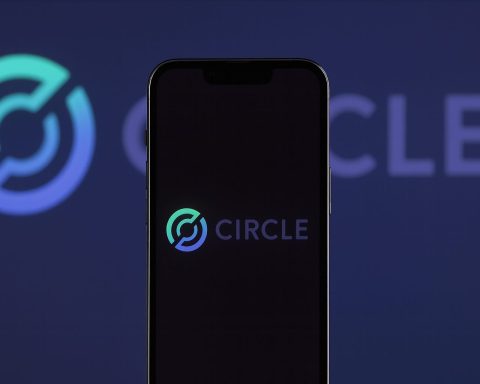Quantum Computing Inc (NASDAQ: QUBT) heads into the new trading week with fresh analyst support, a place on new “best quantum stocks” lists and lingering questions about valuation after another roller‑coaster stretch for the stock.
QUBT stock snapshot for November 23, 2025
U.S. markets are closed today (Sunday), so the latest full trading data for Quantum Computing Inc are from Friday, November 21, 2025.
- Last close: QUBT finished Friday at $10.20, down about 0.7% on the day from a previous close of $10.27.
- Intraday range: The stock traded between roughly $9.50 and $10.52 on heavy volume of about 25 million shares. [1]
- Size & volatility: At these levels, QUBT’s market capitalization sits near $2.3 billion, with a beta around 3.8, meaning the stock tends to move several times more than the broader market. [2]
- 52‑week range: Over the past year, the shares have swung between roughly $4.3 and $27.15, underscoring just how speculative the name remains. [3]
Despite Friday’s dip, QUBT is still dramatically higher than it was a year ago. Schaeffer’s Research notes that, as of the post‑earnings rally on November 17, the stock was up about 282% year‑over‑year but still down roughly 30% in 2025, with approximately 16.3% of its freely tradable float sold short — a combination that helps explain the violent squeezes and pullbacks traders have seen this year. [4]
After hours on Friday, MarketBeat data showed QUBT changing hands around $10.24, a modest 0.6% bounce that still leaves the share price about 17% below Tuesday’s post‑earnings closing high around $12.34. [5]
Today’s headline: Wall Street Zen upgrades QUBT to “Hold”
The most stock‑specific news dated November 23, 2025 is an analyst‑ratings update: AmericanBankingNews reports that Wall Street Zen has raised its view on QUBT from “strong sell” to “hold.” [6]
According to that report:
- Wall Street Zen’s change leaves QUBT with two Buy ratings, one Hold and one Sell among tracked brokerages.
- Across those firms, the consensus rating is now “Hold”, with an average 12‑month price target of $23.67 — implying around 130% upside from Friday’s close near $10.20. [7]
The same article highlights just how divided coverage remains:
- Lake Street Capital recently cut its price target from $24 to $16 but maintained a Buy rating.
- Weiss Ratings currently assigns QUBT a “sell (D‑)” grade.
- Ascendiant Capital Markets previously lifted its target from $22 to $40, reiterating a Buy. [8]
That spread — from “sell” to “buy” and from $16 to $40 on targets — captures today’s core tension around QUBT: analysts agree the story is important but profoundly disagree on what the business is worth.
The AmericanBankingNews piece also recaps key metrics: QUBT opened Friday at $10.18, with a 50‑day moving average near $16.87 and a 200‑day moving average around $15.99, meaning the stock is now trading well below its recent trend lines even after November’s rally. [9]
Fresh nod from “best quantum stocks” lists
Also dated November 23, Zacks Investment Research updated its “Best Quantum Computing Stocks to Buy for November 2025” feature and included Quantum Computing Inc (QUBT) in the group. [10]
In that list, Zacks highlights QUBT as a company that “develops photonic‑based systems” for quantum computing and related high‑performance workloads, effectively positioning it among a small cluster of speculative names that offer direct exposure to the quantum‑hardware theme. [11]
However, not all recent commentary is upbeat. A Yahoo Finance valuation piece from November 22 notes that QUBT shares have fallen by more than a third over the past month and a similar amount over the last three months, despite the company’s strong cash position and post‑earnings spike — raising the question of whether much of the quantum hype is already reflected in the price. [12]
Recap of a wild week: from earnings euphoria to profit‑taking
MarketBeat’s QUBT news feed reads like a day‑by‑day diary of last week’s volatility. [13]
- November 14 (Friday): QUBT reported Q3 results and multiple outlets flagged double‑digit intraday gains as the stock reacted to better‑than‑expected revenue and detailed a new roadmap for photonic and quantum manufacturing. [14]
- November 17 (Monday): Headlines such as “Trading 5.7% Higher on Strong Earnings” and a Schaeffer’s Research piece titled “Quantum Computing Stock Soars After Top‑Line Beat” described the stock up around 12% to roughly $11.88 that morning. [15]
- November 18 (Tuesday): MarketBeat recorded QUBT up 7–8% intraday and asked whether it was “still a buy” as the stock pushed toward the mid‑$12s. [16]
- November 19–21 (Wednesday–Friday): Subsequent headlines flipped negative — “Shares Down 6.3%,” “Trading Down 11.2% – Time to Sell?” — as profit‑taking and macro jitters sent the stock sharply lower into the weekend. [17]
Daily data from StockAnalysis shows just how sharp that round‑trip was: $10.60 close on Nov. 14, $11.50 on Nov. 17, $12.34 on Nov. 18, then $11.56, $10.27 and finally $10.20 by Friday. [18]
In practical terms, QUBT gave back about 17% from Tuesday’s high to Friday’s close, and roughly 4% of its initial earnings rally, a classic speculative blow‑off followed by swift mean‑reversion. [19]
Q3 2025 results: tiny revenue, big percentage growth
Fundamentally, Quantum Computing Inc is still in the very early innings of commercialization.
According to the company’s official Q3 2025 earnings release and a follow‑up analysis from Zacks: [20]
- Revenue: About $384,000 for the quarter, up from roughly $101,000 a year earlier — an increase of nearly 280% year‑over‑year and far ahead of the roughly $120,000 Wall Street expected.
- Earnings: An adjusted loss of $0.05 per share, slightly better than the $0.06 loss in Q3 2024 and in line with consensus estimates.
- Gross margin: Expanded to around 33%, compared with 9% a year ago.
- Operating expenses: Jumped to roughly $10.5 million, more than double the prior‑year quarter as research & development, sales & marketing and G&A all saw triple‑digit percentage growth.
As a result, operating loss for the quarter was still about $10.4 million, and the company remains far from breakeven. [21]
On the positive side, management emphasized several new or growing revenue streams:
- Initial cloud‑based revenue from the Dirac‑3 quantum optimization system.
- Progress in quantum AI and cybersecurity offerings, including what the company calls its first U.S. commercial sale of quantum cybersecurity solutions via a purchase order from a top‑five U.S. bank. [22]
These small but symbolic wins underpin the bullish view that today’s prototype‑scale contracts could eventually lead to larger deployments across finance, aerospace and government.
Cash war chest built on massive share issuance
QUBT’s balance sheet is arguably as important to the stock story as its income statement.
Zacks points out that QUBT ended Q3 with around $352.4 million in cash and equivalents, up from about $348.8 million in Q2. That cash position reflects an aggressive financing strategy:
- During the quarter, the company raised roughly $500 million via a private placement of common stock.
- After quarter‑end, it raised an additional $750 million in another oversubscribed private placement. [23]
Those deals came on top of earlier equity raises in January 2025 ($100 million) and June 2025 ($200 million), as well as multiple offerings in late 2024. [24]
This strategy has left QUBT with:
- A very large cash buffer relative to current revenue.
- A rapidly expanding share count, now around 224 million shares outstanding. [25]
According to StockAnalysis, the company generated about $546,000 in revenue over the last twelve months, implying that today’s roughly $2.3 billion market cap values QUBT at more than 4,000 times trailing sales — a level that even bullish observers concede is highly speculative and requires years of successful execution to justify. [26]
Investors have already demonstrated a low tolerance for additional dilution. In late September and early October, GuruFocus reported that Quantum Computing planned to offer over 26 million new shares, part of a broader series of financings totaling up to $500 million, and the stock fell by double digits on the news. [27]
Technology roadmap: Neurawave and the Tempe photonic foundry
On the technology front, Quantum Computing Inc is betting on integrated photonics rather than the superconducting or trapped‑ion architectures favored by many rivals.
Neurawave photonic reservoir computer
On November 17, QUBT announced Neurawave, a photonics‑based reservoir computer implemented as a standard PCIe card, which the company is debuting at the SuperCompute25 (SC25) conference in St. Louis. [28]
The system:
- Combines optical computing with digital electronics.
- Targets high‑performance computing, AI inference and complex signal‑processing workloads.
- Is designed to integrate into existing servers via the PCIe interface, aiming to bring photonic acceleration into more conventional data‑center environments. [29]
Analysts covering the stock view Neurawave as an important proof‑of‑concept for QUBT’s photonic approach — but also caution that meaningful revenue from such systems is likely to take time, given the need for software integration, ecosystem support and early customer validation. [30]
Tempe photonic foundry and POET collaboration
Neurawave sits on top of QUBT’s expanding chip‑fabrication capabilities:
- In May 2025, the company held a ribbon‑cutting ceremony for its quantum photonic chip foundry in Tempe, Arizona, which is already fulfilling customer pre‑orders and is positioned to scale production of thin‑film lithium niobate (TFLN) photonic chips for datacom, telecom, sensing and quantum applications. [31]
- Management describes the Tempe facility as a cornerstone of a multi‑phase growth strategy, enabling domestic, vertically integrated manufacturing for both external customers and QUBT’s own quantum machines. [32]
Earlier this month, the company also announced a partnership with POET Technologies to co‑develop 3.2 Tbps optical engines built around TFLN modulators, targeting co‑packaged optics and next‑generation AI connectivity, which could extend its reach into the high‑bandwidth networking ecosystem. [33]
Beyond commercial customers, QUBT continues to work with government and research institutions, including contracts tied to NASA’s LiDAR data analysis and quantum sensing, positioning the company within a wider network of federally backed quantum projects. [34]
Policy tailwinds: “Quantum First” goal lifts the sector
Part of the enthusiasm around QUBT this month stems from sector‑wide news rather than company‑specific headlines.
A recent TipRanks article highlighted that U.S.‑listed quantum computing names — including QUBT, IonQ, Rigetti and D‑Wave — rallied in pre‑market trading after the U.S.–China Economic and Security Review Commission recommended that Congress adopt a national “Quantum First” goal by 2030. [35]
The commission’s 2025 annual report calls for:
- Large‑scale investments in quantum hardware.
- Expanded workforce training and research infrastructure.
- Creation of a Quantum Software Engineering Institute. [36]
While the proposals don’t target specific companies, they signal that Washington sees quantum information science as strategically important, which could eventually mean more grants, government contracts and public‑private partnerships for domestic players like QUBT — especially those offering U.S.‑based manufacturing capabilities through facilities such as the Tempe foundry. [37]
For now, these are potential tailwinds rather than guaranteed revenue, and investors will be watching to see whether Congress translates “Quantum First” rhetoric into CHIPS‑style funding programs in 2026 and beyond.
Dueling narratives: bulls vs. bears on QUBT
The bullish case
Supporters of QUBT tend to emphasize three main pillars:
- Technology & differentiation
QUBT’s integrated photonics approach, Tempe foundry and Neurawave system collectively aim to deliver room‑temperature, low‑power quantum and AI hardware, which — if successful — could be easier to deploy than cryogenic systems. [38] - Balance sheet strength
With hundreds of millions of dollars in cash and no need for near‑term debt financing, QUBT has more runway than many early‑stage quantum peers, giving it time to refine products and pursue partnerships. [39] - Scarce pure‑play exposure
Zacks’ coverage and multiple “top quantum stocks” lists position QUBT as one of a handful of publicly traded pure‑play quantum hardware names, which can attract speculative capital whenever quantum computing cycles back into the spotlight. [40]
The bearish case
Skeptics focus just as strongly on the risk side:
- Extreme valuation: Articles summarized on StockAnalysis and Reuters note that QUBT’s share price has risen several hundred percent over the last year while trailing revenue remains well under $1 million, leading some analysts to call the stock “dramatically overpriced” or to warn that pricing these names is “more art than science.” [41]
- Momentum shift: A quantitative review by Artificall calculates that while QUBT climbed about 1,261% over the past two years, it fell roughly 17–18% between early September and November 23, with indicators suggesting decelerating momentum. That analysis assigns QUBT a C+ composite grade and stresses that recent weakness may signal a shift from runaway trend to choppier range‑bound trading. [42]
- Profitability & dilution: TradingView data show EBITDA around –$33 million with an EBITDA margin near –5,900%, while Zacks emphasizes that operating expenses are rising faster than revenue. Repeated equity raises — including offerings of 26‑plus million shares — have already triggered sharp sell‑offs and could continue to dilute shareholders if the company taps markets again. [43]
On top of that, Schaeffer’s flags elevated short interest (~16% of float) and a high put/call volume ratio, suggesting that many traders are still betting against QUBT even after the November spike — a setup that can fuel both additional squeezes and brutal downdrafts. [44]
Key risks and what to watch after November 23
Beyond ordinary market risk, several specific issues stand out for QUBT:
- The company is still deeply loss‑making, with negative EBITDA in the tens of millions of dollars and a revenue base measured in hundreds of thousands, not billions. [45]
- QUBT has relied heavily on issuing new equity to fund operations and expansion, which has already led to significant shareholder dilution and could do so again if cash burn remains high. [46]
- The company has faced class‑action litigation and past Nasdaq compliance issues, illustrating governance and regulatory risks that can flare up in the form of legal costs or headline pressure. [47]
Looking ahead from November 23, 2025, traders and longer‑term investors will likely focus on:
- Neurawave traction: Early feedback, proofs‑of‑concept and any design‑win announcements coming out of SuperCompute25 and follow‑on customer engagements. [48]
- Foundry utilization: Evidence that the Tempe TFLN foundry is ramping beyond pilot pre‑orders into sustained, repeat business in datacom, telecom and sensing markets. [49]
- Use of cash & future raises: Clearer commentary on how management plans to deploy its large cash pile — and whether it can grow revenue meaningfully without another major share sale. [50]
- Policy follow‑through: Any concrete legislative or funding steps that emerge from the “Quantum First” recommendations, which could benefit U.S.‑based quantum and photonic manufacturers. [51]
For now, Quantum Computing Inc enters the new week as one of the most polarizing stocks in the quantum‑computing space — newly upgraded to “Hold,” featured on bullish stock lists and yet trading at a valuation that assumes years of successful execution in an uncertain field.
Disclaimer: This article is for news and informational purposes only and does not constitute financial advice, investment recommendation or an offer to buy or sell any security. Quantum‑computing stocks like QUBT are highly volatile and speculative. Always do your own research and consider consulting a qualified financial professional before making investment decisions.
References
1. stockanalysis.com, 2. www.americanbankingnews.com, 3. www.americanbankingnews.com, 4. www.schaeffersresearch.com, 5. www.marketbeat.com, 6. www.americanbankingnews.com, 7. www.americanbankingnews.com, 8. www.americanbankingnews.com, 9. www.americanbankingnews.com, 10. www.zacks.com, 11. www.zacks.com, 12. www.marketbeat.com, 13. www.marketbeat.com, 14. finviz.com, 15. www.marketbeat.com, 16. www.marketbeat.com, 17. www.marketbeat.com, 18. stockanalysis.com, 19. stockanalysis.com, 20. www.prnewswire.com, 21. finviz.com, 22. finviz.com, 23. finviz.com, 24. quantumcomputinginc.com, 25. stockanalysis.com, 26. stockanalysis.com, 27. www.gurufocus.com, 28. www.prnewswire.com, 29. quantumcomputingreport.com, 30. www.investing.com, 31. quantumcomputinginc.com, 32. quantumcomputinginc.com, 33. quantumcomputinginc.com, 34. quantumcomputinginc.com, 35. www.tipranks.com, 36. www.tipranks.com, 37. quantumcomputinginc.com, 38. quantumcomputinginc.com, 39. finviz.com, 40. finviz.com, 41. stockanalysis.com, 42. artificall.com, 43. www.tradingview.com, 44. www.schaeffersresearch.com, 45. www.tradingview.com, 46. finviz.com, 47. stockanalysis.com, 48. www.prnewswire.com, 49. quantumcomputinginc.com, 50. finviz.com, 51. www.tipranks.com








